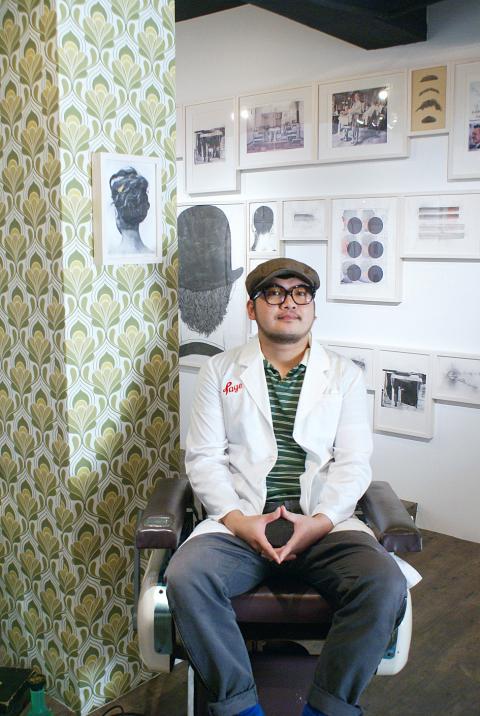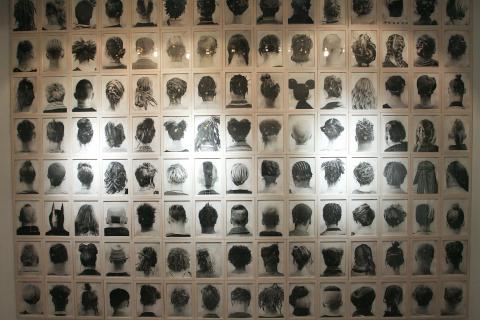Page Tsou’s (鄒駿昇) series of peculiar portraits in The And, Never End — (在視而不見的背後,本質,就在那裡), which is currently on display at the recently opened Agora Art Project x Space (藝譔堂), reverses the traditional form of portraiture by depicting the back of the subjects’ heads.
The face lends portraiture much of its power and demands that the viewer (often superficially) interpret the emotional and physical nuances of the visage he or she is looking at. Depicting the back of the head shifts the emphasis from the subject, freeing it from the constraints of the portrait form. This makes Tsou’s work exceptional.
The articulate, assured winner of several awards and accolades (he has drawn for the popular Swiss author Alain de Botton and the respected artist Quentin Blake, under whom Tsou studied at London’s Royal College of Art), explains the circuitous route that led to the works on display: “At first, I sketched from memory. After a thousand faces, though, I realized that memory has limitations. I couldn’t imagine anymore. At that point I sketched from real life. After 3,000 faces, it suddenly struck me: I’ve been drawing for 20 years and never bothered to focus on the back of the head,” said the artist.

Photo: Noah Buchan, Taipei Times
Tsou’s series is as much about a different way of looking at portraits as it is about how they are presented to viewers. Portraiture typically focuses the eye on one frame — an individual (or small group). The vertical and horizontal arrangement of the 120 medium-sized photos in 120 People in London, hung closely together, prompts a constant shifting of focus. Once accustomed to viewing the overall surface of the photos, however, it becomes apparent that Tsou’s work is about patterns, forms and textures.
Tsou’s pictures could be viewed like a picture of a mountain range — with its peaks and gullies, shadows and light — free from the kinds of psychological interpretations that we might apply to them because that’s what the portrait medium typically demands. These portraits are purely aesthetic.
Tsou emphasizes the landscape of the human head in a number of ways. He blanks out the background with a large white canvas (drawing the viewer’s attention to the head only). The viewer is incapable of determining where the photos were taken, or when. (The black-and-white pictures are reminiscent of daguerreotype photography of the 19th century.)

Photo Courtesy of Agora Art Project X Space
We can speculate — using the subjects’ tattoos, ear piercings and hairstyles, as well as their ethnicity and the title of the piece — that this is multicultural East London. But it could also be Johannesburg. Or Los Angeles. Regardless, this is not the point. Tsou’s pictures are not some psychological, sociological, political or trendsetting portrait of a person or place. They are random assemblages of human forms. Applying an underlying meaning to them is futile.
The above holds true for The And, a series of 27 images shot in a barbershop. Here, photography is partially erased and then replaced by illustration. Tsou says that the medium isn’t important. He’s created portraits using photography, illustration and video and says that it is how we look at the pictures and what they reveal about our own ways of seeing that matters.
Tsou’s images remind us that there is more to portraiture than the psychological disposition of its subjects. With this in mind, when we return to more traditional examples of portraiture, we are better equipped to appreciate their aesthetic beauty.

Exceptions to the rule are sometimes revealing. For a brief few years, there was an emerging ideological split between the Democratic Progressive Party (DPP) and Chinese Nationalist Party (KMT) that appeared to be pushing the DPP in a direction that would be considered more liberal, and the KMT more conservative. In the previous column, “The KMT-DPP’s bureaucrat-led developmental state” (Dec. 11, page 12), we examined how Taiwan’s democratic system developed, and how both the two main parties largely accepted a similar consensus on how Taiwan should be run domestically and did not split along the left-right lines more familiar in

As I finally slid into the warm embrace of the hot, clifftop pool, it was a serene moment of reflection. The sound of the river reflected off the cave walls, the white of our camping lights reflected off the dark, shimmering surface of the water, and I reflected on how fortunate I was to be here. After all, the beautiful walk through narrow canyons that had brought us here had been inaccessible for five years — and will be again soon. The day had started at the Huisun Forest Area (惠蓀林場), at the end of Nantou County Route 80, north and east

Specialty sandwiches loaded with the contents of an entire charcuterie board, overflowing with sauces, creams and all manner of creative add-ons, is perhaps one of the biggest global food trends of this year. From London to New York, lines form down the block for mortadella, burrata, pistachio and more stuffed between slices of fresh sourdough, rye or focaccia. To try the trend in Taipei, Munchies Mafia is for sure the spot — could this be the best sandwich in town? Carlos from Spain and Sergio from Mexico opened this spot just seven months ago. The two met working in the

This month the government ordered a one-year block of Xiaohongshu (小紅書) or Rednote, a Chinese social media platform with more than 3 million users in Taiwan. The government pointed to widespread fraud activity on the platform, along with cybersecurity failures. Officials said that they had reached out to the company and asked it to change. However, they received no response. The pro-China parties, the Chinese Nationalist Party (KMT) and Taiwan People’s Party (TPP), immediately swung into action, denouncing the ban as an attack on free speech. This “free speech” claim was then echoed by the People’s Republic of China (PRC),